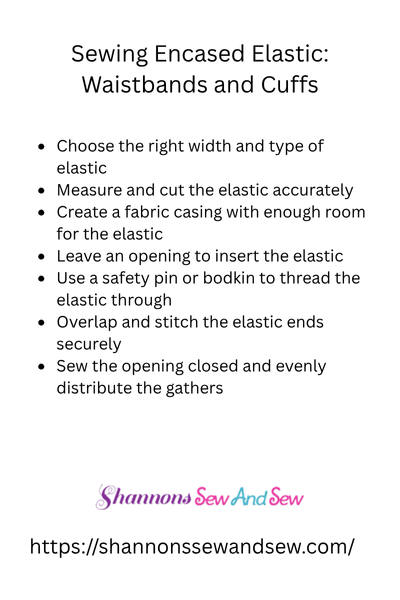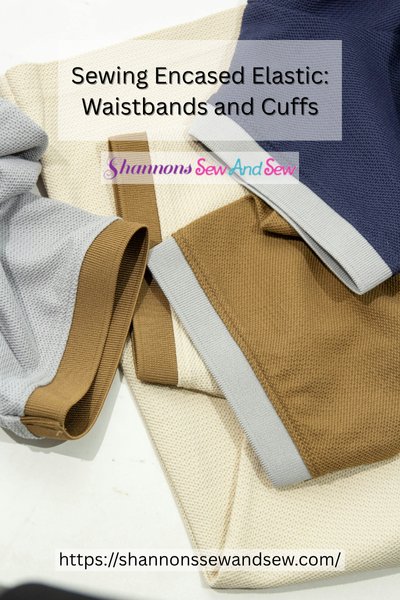Sewing Tips
Sewing Encased Elastic: Waistbands and Cuffs
Sewing encased elastic: waistbands and cuffs can sound like something fiddly or reserved for pro-level stitchers. But hey, don’t worry—it’s way less intimidating than it sounds. I promise, once you try it, you’ll wonder why you ever hesitated in the first place.
Let me take you back to my first elastic waistband attempt. I was making pajama pants (because, why not start with comfort, right?), and I got so excited about finishing them that I completely forgot to leave an opening to thread the elastic through. I had to rip open the seam while my cat judged me from the sewing table. Classic rookie mistake—but you only make it once!
Read More About Sewing Encased Elastic: Waistbands and Cuffs

What Is Encased Elastic, Really?
So, sewing encased elastic is just a fancy way of saying you’re sewing the fabric in a way that the elastic is completely hidden inside a fabric channel. You usually see this in waistbands and cuffs—especially in gym shorts, joggers, pajama bottoms, and even on the sleeve ends of some jackets.
It looks neat, it feels comfy, and it’s surprisingly simple once you’ve done it a few times.
More Things to Know About Sewing Encased Elastic: Waistbands and Cuffs

Waistbands First: Let’s Talk Stretch and Comfort
When it comes to waistbands, sewing encased elastic gives you that sweet combo of stretch and hold. You know that feeling when pants just fit right? That’s thanks to a properly sewn elastic waistband. And once you get the hang of it, you can use this method for everything from casual joggers to more tailored-looking pieces.
One tip I wish someone had told me early on? Don’t skimp on the width of your casing. If you’re using 1-inch elastic, make sure your casing is at least 1¼ inches wide, so the elastic can move freely. Trust me—if the casing is too tight, your elastic will twist and bunch and generally drive you nuts.
Also: always secure the elastic ends before closing up that casing. I’ve had more than one waistband suddenly go limp on me because the elastic slipped inside. Nothing like trying to fish it back out with a safety pin while muttering under your breath.
Cuffs Can Be Sneaky—but Worth It
Sewing encased elastic in cuffs adds a polished, pro-made look to sleeves or pant legs. It also keeps things in place when you’re moving around. Especially handy if you’re making outerwear or scrubs.
You basically use the same method as with a waistband, but on a smaller scale. I usually leave my opening at the seam line (less noticeable that way), and I always do a little backstitch at the start and end of my casing topstitch so it doesn’t unravel in the wash.
And here’s the fun part: once you get good at cuffs, you can play around with puff sleeves or gathered hems too. There’s a lot of creative wiggle room once you’ve got the basics down.
Picking the Right Elastic
If you’re diving into sewing encased elastic: waistbands and cuffs, the type of elastic you use does matter. Woven, braided, knit… each type has its strengths. For example, braided elastic can narrow when stretched, which isn’t always ideal in waistbands. Knit elastic, on the other hand, keeps its width when stretched and works beautifully for most clothing.
For joggers or comfy pants, I go for soft waistband elastic. It sits nicely against your skin and holds up through lots of laundry days. For cuffs, narrower elastic (¼” to ½”) usually does the trick—just depends on your pattern and fabric.
Pro-Tips I Learned the Hard Way
One time, I accidentally twisted the elastic inside the casing and didn’t notice until the very end—after I’d closed everything up and even topstitched. I had to unpick half the waistband. So yeah, always check that your elastic isn’t twisted before sewing it shut. It saves you hours and a few gray hairs.
Also, mark your elastic ends when threading—it helps you spot any twists early, and it makes even gathering easier. Stretch it evenly before securing, especially if you’re sewing encased elastic into cuffs where precision matters more.
What Fabrics Work Best?
Light to medium-weight fabrics are ideal for sewing encased elastic: waistbands and cuffs. Think cotton, jersey, linen blends—basically anything that can fold without getting too bulky. If you’re using heavier fabric like denim or fleece, you may need a wider casing and stronger elastic.
From Fabric to Fit—Your Guide to Encased Elastic Success
Once you’ve got the hang of sewing encased elastic: waistbands and cuffs, you’ll start spotting all kinds of ways to use it. From pajamas to joggers to DIY gym wear, it’s one of those sewing skills that really pays off.
It gives your handmade clothes that clean, ready-to-wear finish—and honestly, it’s kind of addictive. There’s something so satisfying about watching that casing come together, elastic neatly tucked inside, all tidy and smooth.
So go ahead, grab your fabric and elastic, and give it a go. Just don’t forget to leave an opening for the elastic (been there), and maybe keep your cat off the sewing table.
Got any funny elastic fails or questions? Drop them in the comments—I’d love to hear about it!






















